NextDoor is a coworking space company based in Paris of which branches are rapidly spreading throughout France. Its coworking space was created after sufficient study of cases and service history of European nations, such as Holland and Germany, where coworking spaces appeared quite a while ago. Thus, the coworking space of NextDoor has a high spatial quality. Considering the fact that NextDoor is a subsidiary of Bouygues Telecom, a major European wireless telecommunications operator, it may be safe to assume that it has had the upper hand over other French coworking space companies in early financial firepower and depth of research.
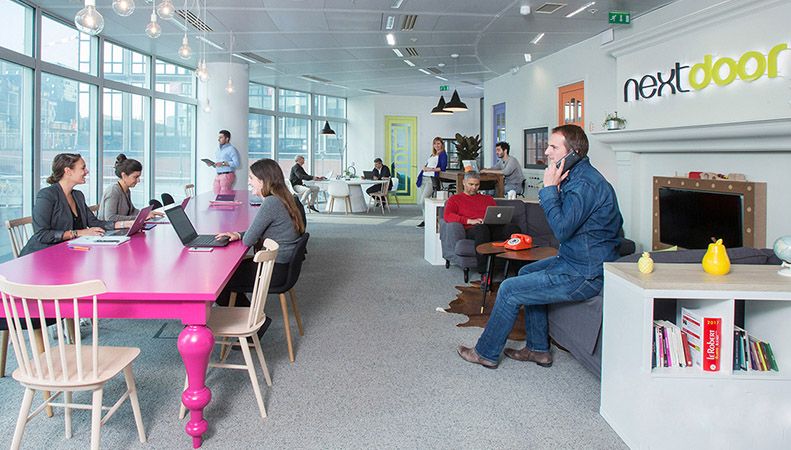
The La Défense branch of NextDoor (Source: https://www.nextdoor.fr)
Until July 2017, NextDoor launched five branches in Paris - Issy-les-Moulineaux, La Défense, Paris Gare de Lyon, Neuilly sur Seine Lyon-part-dieu. This year it is to open two additional branches - Saint-Lazare and Porte d'orléans. Among those branches, the branch I want to introduce here is the one in La Défense, one of the most popular regions in Paris, and the center of French commerce, the only district where high-rises are allowed.
La Défense, The Center of Parisian Commerce
La Défense is a region placed in Western France. Historically it has been continuously performing the role of the center of Parisian commerce. If you drive on a car for 10 minutes along the boulevard lying toward the west from the Arc de Triomphe, you can see an enormous white building that is in the shape of the alphabet ‘U’, La Grande Arche. That is where La Défense is.
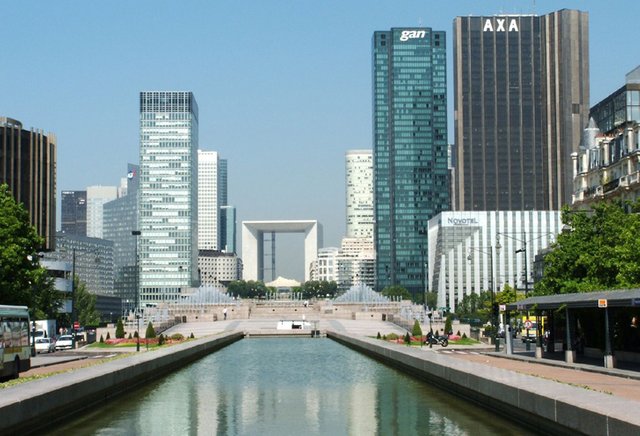
La Grande Arche in La Défense (Source:http://assets.inhabitat.com)
There is an easy way to find La Défense in Paris. If you attain a bird’s eye view of Paris from the Eiffel Tower or Montmartre, you can see a particular region where ten or more floored high-rises are concentrated. That is where La Défense is. Although as a district it belongs to the outskirts of Paris, it has a good transportation system and contains many artworks, making it just seem like part of Paris. Next to the Avenue des Champs-Élysées, it contains many attractions, attracting a large floating population. A good indication of its fluorescence would be the fact that three of Starbucks branches in the whole Paris region, which is only about 20, exist in it.
Corresponding to La Défense’s label as the center of Parisian commerce, at both sides of La Grande Arche two large shopping malls, 'Les Quatre Temps' and 'Cnit', are placed. These two shopping malls are connected to the La Défense subway station underground. As La Défense has a lot of attractions and people, it has a solid transportation system in which metro, RER, bus and taxi are connected. In other words, at it, a transportation means conveniently leads to another, allowing you to easily get to a place you want to go. Also, a lot of head offices of major global conglomerates are concentrated in it and thus, in weekdays you can see many office workers wearing suits. If you visit La Défense on weekdays during morning rush hours or lunchtime, you can get a sight of throngs of French, who are well-known for possessing a refined dress sense.
The First Time in My Life That I Saw Such a Luxurious Entrance to a Coworking Space!
The La Défense branch of NextDoor is the core branch among its five branches. The branch is placed at the first floor of Cœur Défense, a building you can directly see after getting out of the La Défense subway station, so it is easy to access the branch. The Cœur Défense building itself contains great facilities and interior designs, making you feel like entering a great company building. As it is such a large building, once you reach the entrance, you can see big managers residing at the building taking care of people entering it. Don’t fluster yourself; just point toward the NextDoor sign you see at the first floor, and they will kindly guide you.
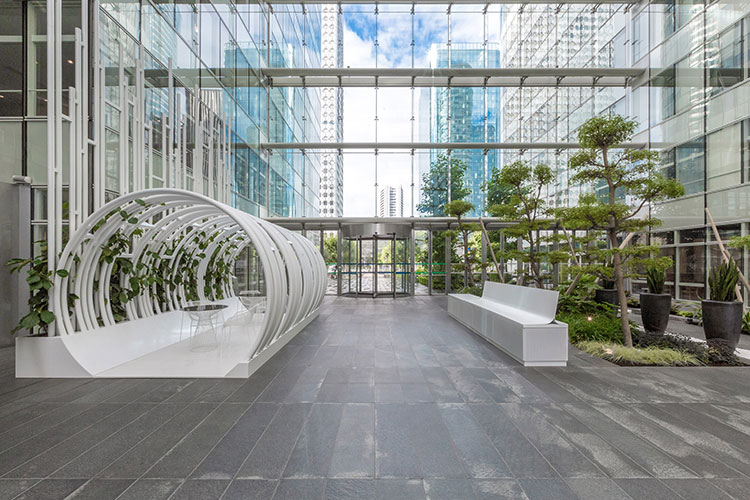
Cœur Défense building lobby (Source: https://www.businessimmo.com)
· The name of the branch: NextDoor - La Défense
· The branch address: 110, the esplanade of General de Gaulle 92931 Paris La Défense
· Transportation: Take the first line of Metro or RER and get off at the La Défense station. Get out through the exit leading to Cnit and walk for a minute.
· Open time: 24 hours
The minimum unit of usage of the La Défense branch of NextDoor is a day. In the case where you use it as a monthly member, it is possible for you to use it for free for a day before the contract. If you register your visit on the NextDoor homepage before you make a visit to the branch, a branch manager will wait for you to kindly guide you once you make a visit to it. In France, most cafés retain conventional forms so like South Korea, in the country, the concept of ‘coworking space’ is still unfamiliar to many people. Thus, managers of the La Défense branch are kind and detailed in their guidance of people who visit a coworking space for the first time. Don’t worry! Different from the common notion that French hate English, French these days are quite good at English. The managers of the La Défense branch are especially proficient in their English communication skills.
One of the advantages of NextDoor is that communications, such as registration or question, can easily take place through online. Once you become an user of NextDoor, you can use a homepage in which you can communicate with other users through online and manage your information. Also, you don’t have to do the legwork; if you enter the NextDoor homepage, with a 360-degree camera, you can check a lobby of each branch and meeting rooms that are various in their sizes. You can also register for space through the homepage, making the service accessible to not only young French generation, but also foreigners.
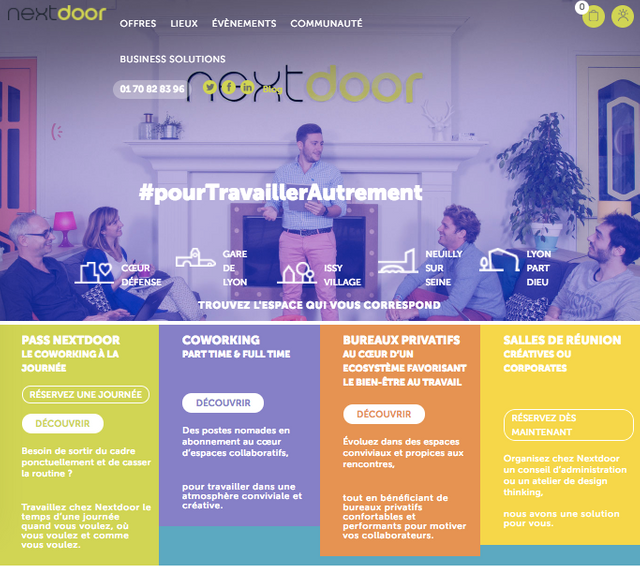
NextDoor Website: www.nextdoor.fr
If I have to point out one weakness, it is that texts on the homepage are only provided in French. But this problem can easily be solved, if you use the Google translator. Apart from the official homepage, through the official Facebook page that NextDoor manages, you can quickly attain new information on coworking space. This indicates that the company has taken into account the fact that most users of the coworking space service are used to online.
Spatial Composition of La Défense Branch, NextDoor
The La Défense branch of NextDoor is composed of four types of space: lounge, coworking space, private office and meeting room. In front of the main entrance of the coworking space, there is a sofa on which anyone can sit, even if one is not a member. This space is rather a waiting space so it is not included as a main space.
(1) Lounge
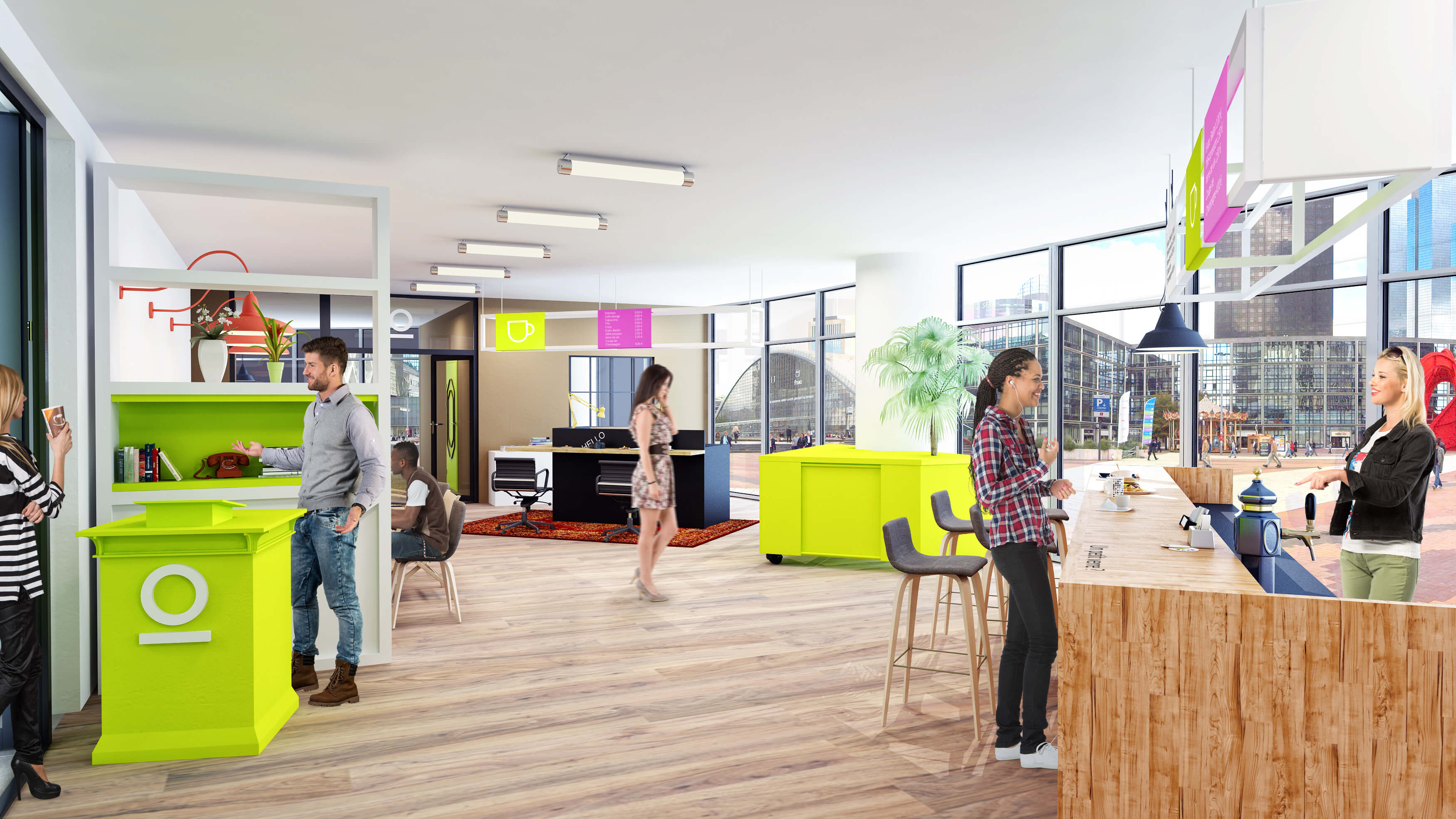
Lounge of the La Défense NextDoor(Source: https://www.nextdoor.fr)
Once you enter through the entrance of NextDoor, the lounge appears, where people are boisterously speaking to one another, reading magazines, drinking coffee or playing games. The place has comfortable atmosphere so right after opening the door the awkward feeling of visiting a new place for the first time vanished. The picture below is the official picture of the place on the homepage, but the place is in reality more bright and cheery than this picture suggests. The coworking space of France felt attractive to me, who was in my 30s, in an enigmatic way; it was different from coworking spaces in the United States which are filled with people in their 20s wearing shorts and T-shirts in that although the place was filled with white-collars wearing suits and dress shirts, it did not feel too formal or stuffy.
At the entrance of the lounge were a number of managers who were guiding people or helping their usage. At the opposite juice bar there was an attractive staff who was providing people with coffee or drink. Although it was called lounge, the place had on several spots tables that could be seen in cafés, rather than sofas. Thus, along with people who were resting, it was not difficult to see a number of people who were working at tables or working through their phones.
At one side of the lounge there was a standing table around which about ten people could share casual conversations and a large screen. When lunchtime was about to be over, I could see there quite a number of people having coffee or playing video games. At an ordinary company lounge, all you can do is waiting for someone or something or having simple conversations with others. On the contrary, at the lounge of NextDoor various types of furniture were intentionally placed, inducing users to engage in various activities. In other words, this lounge reflected the meaning of the name coworking space.
(2) Coworking space
Most of coworking spaces I saw in Holland, the United Kingdom and Germany did not have lounge and coworking space clearly separated. What this means is that when I opened the main entrance of a coworking space, the first space that appeared was a lounge and a coworking space at the same time. However, the La Défense branch of NextDoor had the lounge and the coworking space clearly separated by a wall; in the former some noise was allowed and the latter was a quiet working space.
Thus, the atmosphere of the coworking space is quite different from that of the lounge, which is free and relaxed. It is a ‘working space’. The major difference between atmospheres of two spaces is caused by existence and non-existence of loud noise. Systemically they are also different, as although the lounge can be accessed by anyone, only people with formal membership can access the coworking space.
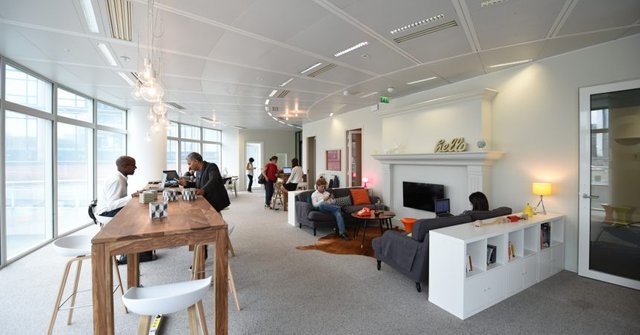
Coworking Area of NextDoor (Source: https://www.nextdoor.fr)
The noise level of the coworking space is as that you can find in daily life. It is not too quiet like a reading room; you do not have to walk on eggshells while flipping a page of a book. Neither is it too noisy, disturbing your work. The noise level is just enough. As you can see in the picture above, through glass panels that are surrounding the coworking space natural light comes in and you can see the sight of La Défense so even if you work long hours you feel less tired. Through a window you can see people coming in and going out of La Défense. It is like seeing a video that captures a day in a European city.
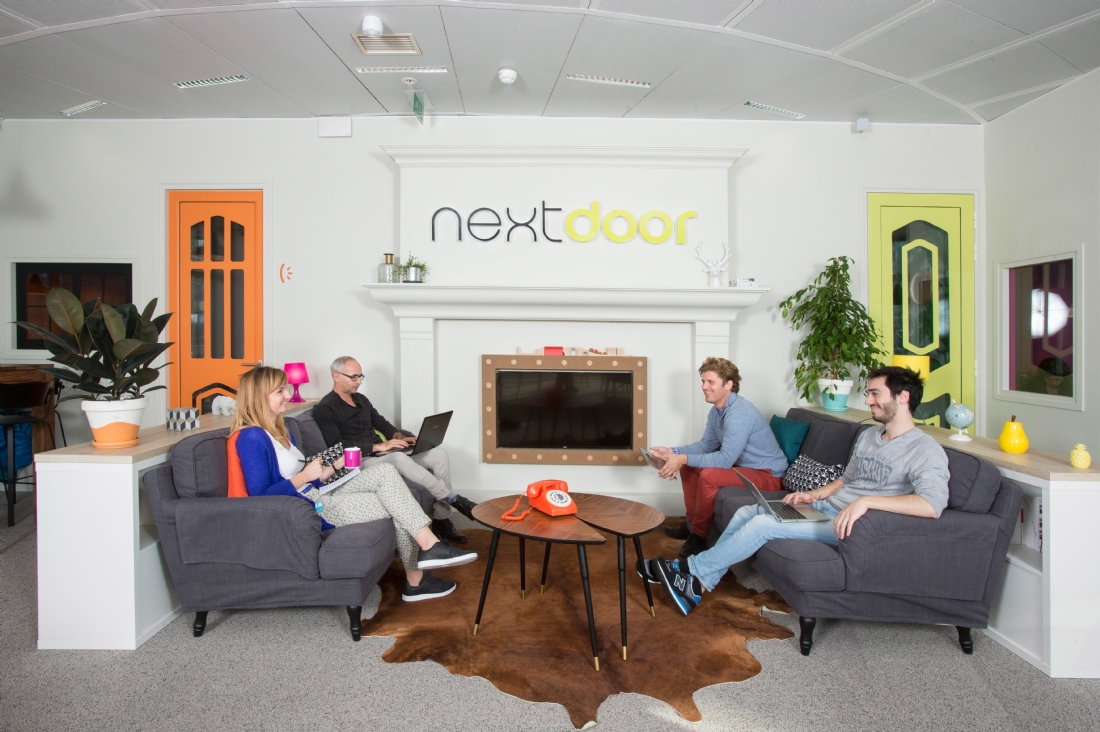
Coworking Area of NextDoor (Source: http://www.decision-achats.fr)
Because there is no designated spot at the coworking space, you can freely move around. Of course, there is wifi and on several spots there are large tables with electric sockets and comfortable sofas that create café-like atmosphere. There is a desk for individual use heading toward a window, a phone booth where you can make a call, and a comfortable nook. At the entrance there is a place where you can keep your jacket and a locker.
Personally, what I liked about working at the coworking space of NextDoor was that the gender ratio of users was about 50 to 50 and that atmosphere was orderly enough and not too noisy. The place did not feel artificial or formal.
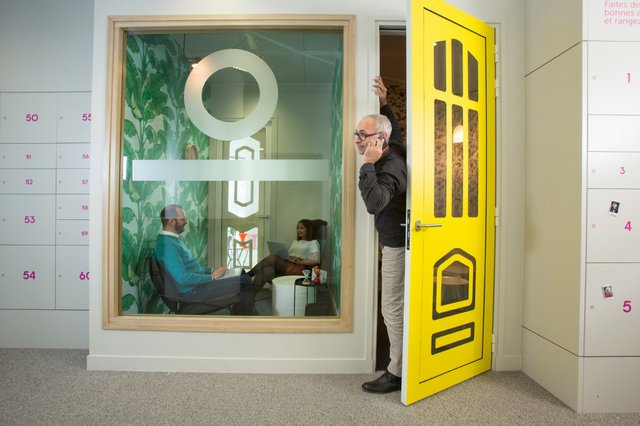
Coworking Area of NextDoor (Source: http://www.decision-achats.fr)
By the way, some coworking spaces concentrate too much on their appearance and spatial efficiency that they become model houses where it is difficult to live in. In other words, they might appear good but they are actually difficult and inconvenient to use.
On that matter, NextDoor is a clean and comfortable space where users can work for a long time. It is big enough so you don’t get too much attention for going in and out. It is a space where even if tables and chairs are quite not in order, it is difficult to notice. It is a space not spectators but users feel comfortable in. I think that any space should make a user feel comfortable enough so that one can be a part of that space and that this is how a space reaches its purpose. On that matter, I felt that NextDoor understood well such dynamics between the space and the user.
(3) Private office
If the left side of the lounge is the starting point toward the coworking space, the right side of it is the starting point toward the private office and the meeting room. private offices of NextDoor are various in their sizes; some are for 2 people, and some are for 6. When I visited, all offices were filled with members of companies. I was not allowed by a manager to take pictures of people who were working so instead I share a picture of another office in another branch, Issy-les-Moulineaux, posted online. There are no people in the picture so it may feel empty. View it while noticing that space with people and space with only furniture feel very different.
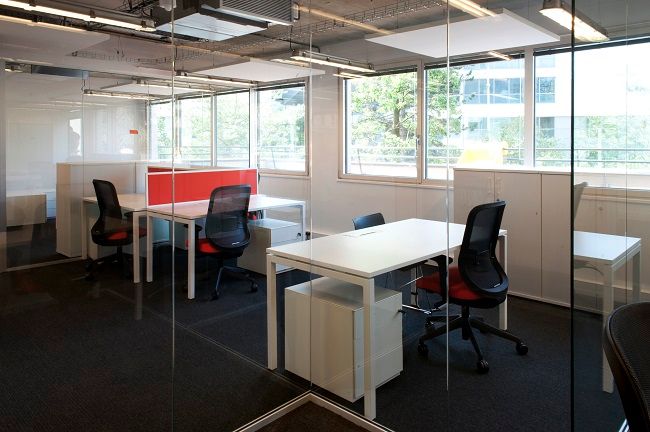
Private office of NextDoor (Source: http://tempsreel.nouvelobs.com)
I could check at once on the lounge bulletin boardbusiness cards of companies who moved to private offices for the network amongNextDoor members. Most of them were small-sized companies, but some businesscards were from big companies. I asked a manager who they were and he answeredthat they were either TFTs of big companies or workers from regional offices ofcompanies that do not yet have official branches. I noticed that they were too welldressed to be people from start-ups.
(4) Meeting Room
At the end of the hall along which private offices lied, there were meeting rooms in various sizes. Some meeting rooms were small, for 2 people, and some were quite big, for 16 people or more.
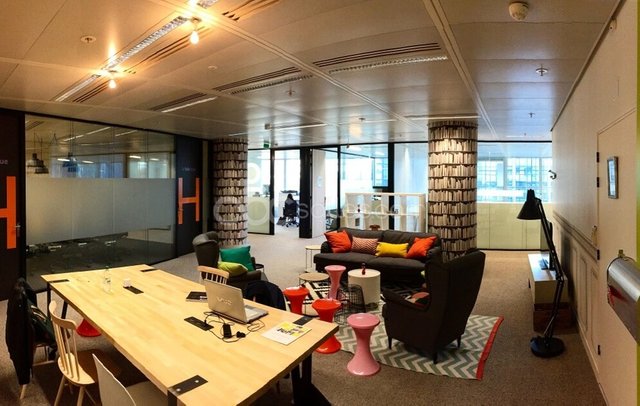
NextDoor (Source: http://www.abcsalles.com)
If you think that all meeting rooms are composed of large tables and office chairs, you are wrong. Although there were typical office-type meeting rooms, there were meeting rooms with rocking chairs, hammocks and low sofas, so low that if you had lied on it, you might had felt as if you were lying on the floor. In the case of large meeting room, chairs could be arranged in a lecture room manner if several people were to listen to a lecture there, but that seemed to not be always the case. Typical office-type meeting rooms seemed suitable for occasions when you have to make a contract with a partner company and casual meeting rooms seemed suitable for occasions of brainstorming activities.
· Size: Varies from a small meeting room for 2 people to alarge seminar room for 16 people or more
· Usage fee: Begins from 30 euro per hour (excluding VAT)
· Online reservation and meeting room photos: https://www.nextdoor.fr/salles-de-reunions.html
From Practical Network-type Membership to Cost-effective Monthly Membership
(1) NextDoor Pass
As regards cost, coworking space is an expensive service. A monthly usage can make you pay hundred thousands of won. Thus, it is advisable that you use the service for at least a day or two before you make the final decision. In that sense, this membership is a key to opening the first door of NextDoor. One time usage per month seems like an ostensible benefit and such membership is for people who are interested in network of NextDoor, rather than its space.
· 20 euro for a month (Only possible through online registration)
· Allows one-time usage of NextDoor for a month
· Registrationto NextDoor network
· Participation in NextDoor events
(2) Day Coworking
This membership is advisable for people who want to use NextDoor while travelling or taking a business trip or for people coming from another region who want to try out a new branch. For a day it is 25 euro. This may seem a bit expensive, as one day usage is 15,000 to 20,000 won in Seoul, but considering prices in Paris, it is actually not that expensive. It’s just about the price of a cup of coffee, so a worker may not feel too much pressure about the cost. In the case of one-day usage, if you make a reservation through online and make a visit, you can receive a service that has been prepared for you. Among European nations, France is where reservation culture is so widespread.
· 25 euro for a day (excluding VAT)
· One-day usage of the coworking space
· Online reservation possible
(3) Monthly Coworking
It is a membership by which you can freely use the coworking space for a month without a designated spot. Although one-day usage is 25 euro, monthly usage is quite cheap. A coworking space in Seoul with similar facilities costs on average about 300 euro, but this membership costs 210 euro, about 30 to 40 percent cheaper. Maybe there is no user with this membership who for a month visits the coworking space daily. But at least one probably will make a visit for half of a month.
If you get this membership, you receive a card that allows you to go in and out of the coworking space for 24 hours. At the end of this year, I will stay in Europe for about three months for a fun global project and this is the membership I will get then. Not only is this membership cost-effective, but I like the fact that this branch is at La Défense where I will be residing. To anyone who comes here I will treat a cup of tea!
· 210 euro for a month (excluding VAT)
· Free usage of the coworking space without a designated spot
· Issue of a pass card to the coworking space (24-hourusage)
(4) Private Office
Rental fee in Seoul is expensive, I must admit. Rental fee for an private office at the coworking space at the center of commerce in Paris, which is famous for high prices, is not that different from rental fee in South Korea. The smallest private office of NextDoor that is for 2 people costs a bit more than 600 euro for rent. As the size of an private office increases, so does the cost.
As regards a private office, regardless of a brand or a branch, it is best to make a visit yourself and sit on a chair you will use. For even if the size of the private office is the same, depending on which company has rented a nearby private office, the atmosphere is quite different. If there is a Korean company that wants to set up a temporary office at Europe, I highly recommend the La Défense branch of 'NextDoor'. Its price is alright, its place is alright, and it’s the best place for you to form a network with global companies.
· Begins from 620 euro for a month (excluding VAT)
· There is a benefit as regards usage of a meeting room and OA facilities.
NextDoor, Where You Can Foresee Next of France
Honestly speaking, in 2016, coworking space in France was low in its quality compared to services of other European nations. I think one of the reasons is, ironically, traditional café culture. As everyone knows, France has strong café culture. If you just pass by a house, a café appears. French are people who can discuss philosophy and culture for hours after ordering a cup of coffee. To them café is not simply a place where you drink coffee. It is part of their daily lives.
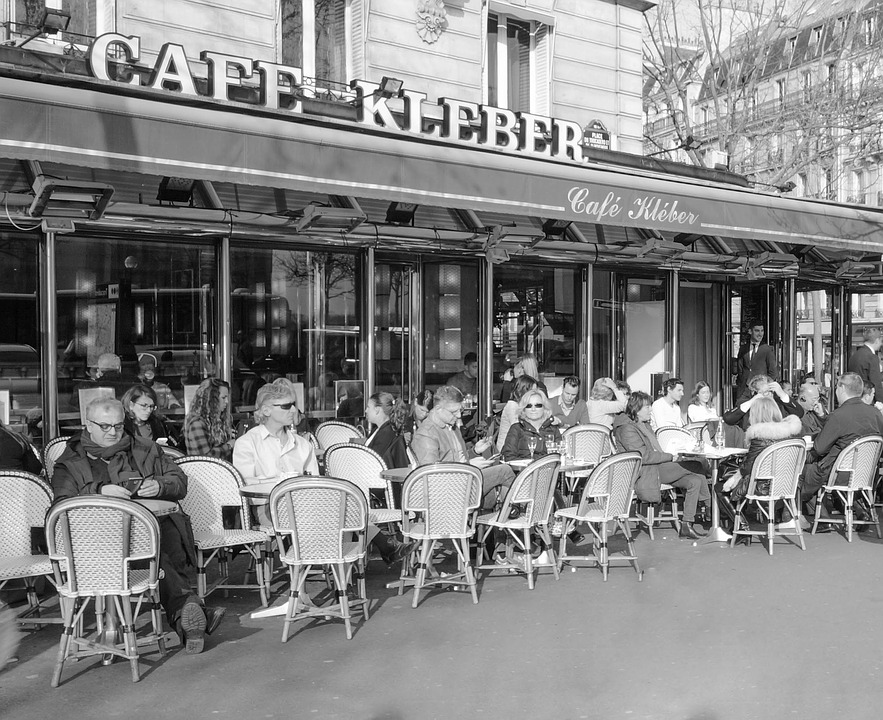
Café Street in Paris (Source: https://pixabay.com)
As the nation for so long had its own café culture, it was difficult for new forms of café culture to settle into the nation. According to statistics in 2015, 850 Starbucks branches had entered Korea; at that time, Starbucks branches in Paris were not even 20. Even if we consider the size difference of regions, numbers of Starbucks branches in Seoul and in Paris significantly differ. But there is a fun twist here. Different from what ordinary Parisians expect, those few Starbucks branches in Paris are all filled with people. In many cases, you have to share a table with people you don’t know. And it is usual for one to wait for a spot one can sit on to appear, after ordering coffee.
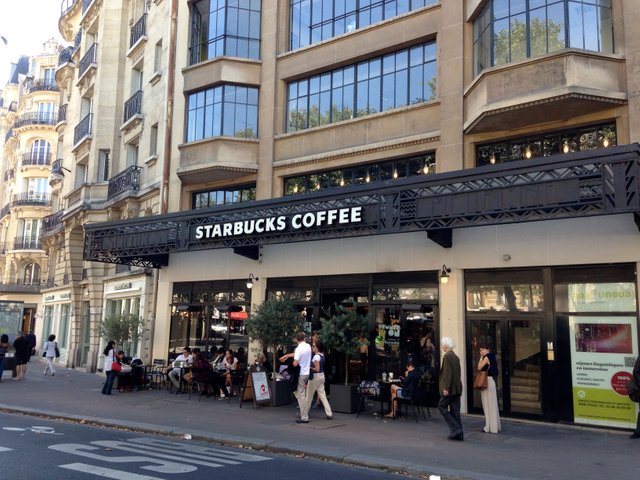
Crowded Starbucks in Pairs (Source: http://martyalmquist.com/starbucks-in-paris)
There are some people who say: because French hate American culture and like traditional French cafés, they do not go to Starbucks. Thus, most of people who enjoy going to Starbucks are foreigners. However, I have visited Paris seven times or more and drunk tens of coffee at Starbucks, and I can tell you from my own experience, that is not true at all. Most of Starbucks users are actually French. Young French who are used to smartphones and laptops were working or enjoying their routine at Starbucks cafés. I could only sometimes spot foreigners who were visiting Paris.
To me the reason for this is so clear. There is no café other than a Starbucks café where people who are used to wifi, electric sockets, coffee that is enjoyed alone, mobile and office can go. Thousands of French cafés that are without wifi and electric sockets cannot be replacement of Starbucks to them. In other words, French café culture is changing, and there are only few cafés that have adapted to such change.
I first noticed such change in 2014. It was that time I mentioned ‘coworking space’ to my families and friends who were living in France. It didn’t matter whether French realized it or not. Soon French young generation needed coworking spaces and searched for and talked about such places all the time.
Another ground for me to say this is, apart from Starbucks, ‘Anti Café’. Anti Café is something like the former version of coworking space. At the time Paris had a number of them, and they were very popular, beyond anyone’s imagination. This was a system where although you had to order coffee, you could freely drink beverage and eat snack by paying about 3 to 5 euro per hour. Anti cafés were so popular that there was usually no sit. Usage fee was quite high. But I think they were popular because they were almost only places in Paris that had abundant wifi, electric sockets and tables at which one could work with one’s laptop.
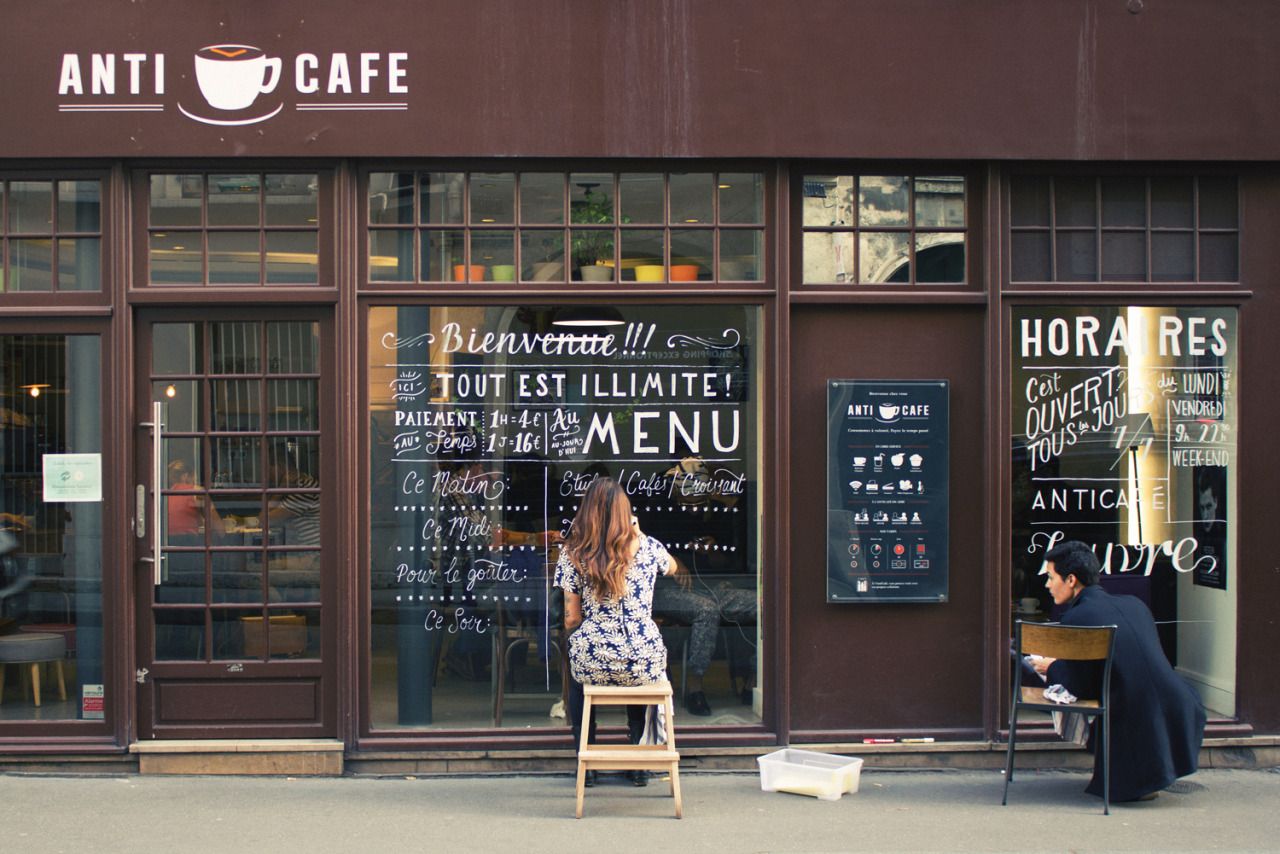
Anti Café in Paris (Source: http://willletterforlunch.com)
I think Bouygues Telecom has well perceived change in working style of French young generation. I also think coworking space, which is based on this prediction, is operating fine. If private offices that are almost always filled with people and crowded lounges aren’t evidence of this, I don’t know what is.
I heard that many people who are taking a business trip to Paris either stay in La Défense or participate in a conference held there. If you have a free day, I recommend you to work for a day at the La Défense branch of NextDoor, which is a hot place in Paris. You don’t have to work for 8 hours or more. Just by looking at how French office workers work and form a network, your business trip will become much more meaningful enough.
Hi! I am a robot. I just upvoted you! I found similar content that readers might be interested in:
https://medium.com/@urwellxcome/a-travel-report-of-nextdoor-la-d%C3%A9fense-branch-in-france-9aa02ce36ebf
Downvoting a post can decrease pending rewards and make it less visible. Common reasons:
Submit